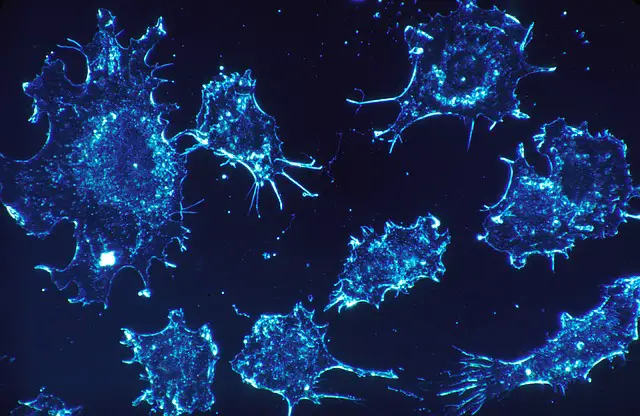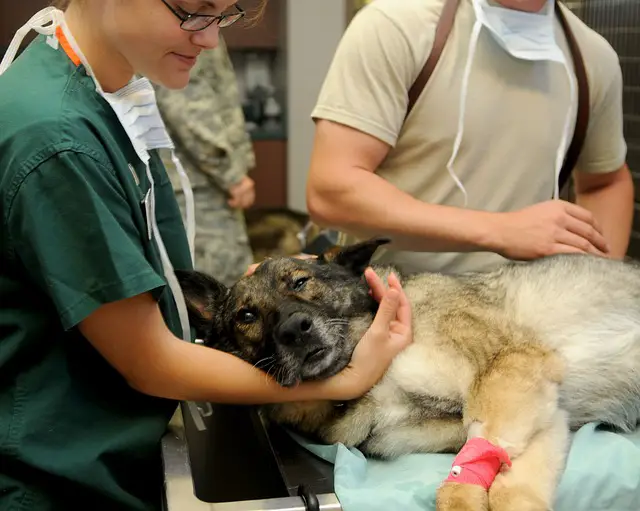
Learning that your dog is down with lymphoma can make you feel quite dreary. You’ve probably also heard of prednisone for treating the cancer. Your being here tells us that much. If you’re wondering what to expect when treating dogs with cancer with prednisone, you’re right on time.
Table of Contents
What Is Lymphoma?
Lymphoma is a blood-borne cancer specifically a cancer of the white blood cells. It occurs in different forms in dogs and closely resembles human non-Hodgkin’s lymphoma in its presentation.
What is Prednisone?
In most vet circles, prednisone is commonly prescribed in the treatment of canine lymphoma as well as other diseases. Oftentimes, it forms part of a treatment regimen rather than a standalone treatment. However, there are some vets who would prescribe the drug as a standalone treatment. Like most medicines, prednisone has its advantages and disadvantages. A primary advantage being its relative affordability and a primary disadvantage being the length of time for which it can be effective.
Today, we educate you on what to expect when treating dogs with cancer with prednisone. Remember that your vet is still the most qualified person to recommend drugs for the treatment of your pet. This article is simply for educational purposes.
Before we get into the article, here is something to think about. In this video, Dr. Susan McMillian explains some facts about prednisone and dogs including dosage, how to administer the drug and some uses and side effects.
How Does Prednisone Work?
Prednisone belongs to a family of drugs called corticosteroids. Corticosteroids occur naturally in dogs and produce cortisol (also known as the stress hormone) when a dog is feeling physically or emotionally stressed, triggering the fight or flight response. Cortisol also helps to suppress autoimmune reactions and because synthetic corticosteroids like prednisone mimic naturally-corticosteroids, they are used to reduce inflammation and suppress overactive immune systems in dogs.
Prednisone belongs to a family of drugs called corticosteroids. This is the same family to which drugs such as cortisone, prednisolone, and hydrocortisone belong.
In vet medicine, prednisone is used to treat a wide range of illnesses in dogs including inflammation, allergies, autoimmune diseases, as well as certain cancers.
Prednisone is not one of those steroid hormones that are naturally produced in a dog’s body, it is made in a lab which makes it a synthetic drug. However, it imitates the work of these natural corticosteroids which is how it performs its work in the body.
Usually, these natural corticosteroid hormones are manufactured in the adrenal cortex. You find the adrenal cortex in the adrenal glands which sit on the kidneys. The adrenal cortex produces cortisol as its main hormone. This hormone is also known as the stress hormone.
When dogs are stressed physically or emotionally, or feel threatened or under stress, cortisol triggers the response of fight or flight. This is why dogs get more aggressive when under stress. They receive a fresh burst of energy courtesy of cortisol.
Cortisol also plays a role in autoimmune reactions — reactions in which white blood cells begin to attack members of the body like these members were foreign bodies.
So, because corticosteroids like prednisone mimick the action of natural corticosteroids, they are great at suppressing autoimmune and inflammatory processes in dogs.
So, in summary, prednisone decreases symptoms of inflammation and suppresses an overactive autoimmune system.
How Is Prednisone Used In Treating Cancers In Dogs?
Prednisone is used to do the following:
- As palliative care.
- To increase appetite.
- To kill cancer cells.
1. As Palliative Care
When cancer gets to a certain stage, palliative care is usually administered to help the patient live a full life for as long as possible.
Sometimes, when cancer gets to the advanced stage, palliative care might even be as good as aggressive treatment in helping the dog live through that critical stage of illness.
In dog cancer, palliative care involves providing the patient with nutritional support so they don’t get malnourished. It also involves suppressing pain in order to improve overall physical and emotional wellbeing.
Seeing how prednisone works, we can easily deduce that prednisone plays a role in palliative care when supporting a dog with cancer.
2. To Increase Appetite

When dogs come down with cancer, they often come down with something known as cancer cachexia. It’s a secondary condition that presents itself as inappetence, loss of weight, anemia, and muscle wasting.
This loss of appetite in dogs with cancer has been attributed to many factors including mechanical abnormalities and iatrogenic consequences.
What are mechanical abnormalities?
These are physical changes in the body as a result of the cancer such as in cases where the dog has a tumor in the mouth or throat, an enlarged spleen or a tumor of the digestive tract. Such abnormalities would, naturally, cause a loss of appetite as eating becomes painful or as in an enlarged spleen, the stomach gets tricked into feeling full too early.
Furthermore, advanced cancer is usually associated with a partial loss of appetite, and in many cases, even complete loss of appetite.
Iatrogenic consequences, on the other hand, are consequences the body faces from the treatment of the cancer. For instance, dogs on chemo or certain cancer drugs naturally lose appetite.
Now, one common side effect of prednisone is an increased appetite. Therefore, prednisone (together with Maropitant citrate which helps with nausea and vomiting) can be used to help boost the sick dog’s appetite.
By the way, if you’re thinking of foods to feed your dog at this time, a general rule of thumb is to go for foods with easy-to-digest fatty proteins. However, please avoid beef and grains. If the food must contain grain, then it must be as few grains as possible. But as usual, your vet is the best person to walk you through food choices for your pooch right now.
[amalinkspro type=”showcase” asin=”B00A8O8JL0″ apilink=”https://www.amazon.com/dp/B00A8O8JL0?tag=dpg-amalinks03-20&linkCode=osi&th=1&psc=1″ new-window=”true” addtocart=”false” nofollow=”true” sc-id=”4″ imgs=”LargeImage” link-imgs=”false” specs=”GRAIN FREE: This healthy dog food is made with free-range chicken and dehydrated for easier digestibility and to lock in nutrients.~~~MODERATE PROTEIN: Balanced levels of calories and carbs make it the perfect maintance diet for adult dogs of all breeds & sizes, especially picky eaters.~~~HUMAN GRADE: The Honest Kitchen meets the rigorous FDA safety standards to use the label human grade, ensuring the highest quality dog food.~~~ALL NATURAL: This dog food is made with no by-products, preservatives or GMO ingredients – just add water for a warm and delicious meal.~~~MADE IN THE USA: All ingredients are processed in the USA in a human grade food processing facility with nothing from China.~~~” btn-color=”#ff9900″ btn-text=”View on Amazon” alignment=”alignnone” hide-prime=”0″ hide-image=”0″ hide-reviews=”0″ hide-price=”1″ hide-button=”0″ width=”750″]The Honest Kitchen Human Grade Dehydrated Grain Free Chicken Dog Food 10 lb – Force[/amalinkspro]
3. To Kill Cancer Cells

Prednisone does kill lymphoma cells which is why it is prescribed. In fact, it can work as a standalone treatment. So, in cases where the pet parent doesn’t want to go with chemo, experts usually prescribe prednisone.
Without chemo, dogs with lymphoma would have about 1 month to live at the most. However, if prednisone is administered, survival times can increase from one month to up to three months. It’s not much, but it’s the best that can be had without treatment.
What Is The Prognosis For Treating Dogs With Prednisone?
Treating dogs with cancer with prednisone as a standalone treatment has been shown to have some benefits, with 50 to 70% of dogs responding to a recognizable degree. At the very least, treatment of prednisone is shown to partially reduce lymph node size. However, even if complete remission is achieved, life expectancy afterward is about 3 to 4 months at the most. Moreover, if, by chance, a dog falls out of remission when on prednisone, further treatment of the disease becomes impossible as Prednisone builds drug resistance in dogs.
Treating dogs with cancer with prednisone as a standalone treatment has been shown to have some benefits no doubt, with 50 to 70% of dogs responding to a recognizable degree. At the very least, a treatment of prednisone is shown to partially reduce lymph node size.
However, in comparison, when on the more encompassing Madison Wisconsin Protocol, 80 to 90% of dogs will typically go into full remission with no sign of cancer whatsoever anymore. These dogs will also go on to live for up to 12 to 18 months after complete remission.
On prednisone, on the other hand, even if complete remission is achieved, life expectancy afterward is quite poor at about 3 to 4 months at the most.
Moreover, if, by chance, a dog falls out of remission when on prednisone, things get even bleaker. Further extension of life is practically impossible as Prednisone has been shown to build drug resistance in dogs. Therefore, further treatment of the disease becomes impossible.
What Are The Side Effects Of Prednisone In Dogs?
- When treating a dog with cancer with prednisone, you can expect to see your dog experience the following.
- Insatiable thirst and frequent urination.
- Increased appetite.
- Stomach ulcers and personality changes.
1. Insatiable Thirst And Frequent Urination

Dogs on prednisone typically experience frequent thirsts as well as frequent urination. Therefore, since your dog will be drinking water and urinating more, then you might want to give your dog prednisone in the morning.
Make sure your dog gets access to as much water as he needs. However, you might have to redraw your schedule so the gets more time to go out for a pee.
Also, to avoid your dog peeing in his bed at night while sleeping, don’t allow your dog get more water few hours before bed.
2. Increased Appetite
Prednisone increases appetite in dogs. So, your dog might get hungrier than normal, and therefore, eat more often and in larger doses than normal. In this situation, weight gain is inevitable and you have to watch it.
One way to do this is to only feed healthy low-calorie treats in between meals. Great examples of healthy treats include celery and green beans. (Click here to read our article on dog treats to find out other healthy treat alternatives you can try).
Also, you want to baby-proof your house because your dog might get around to eating weird stuff around the house. Normally, he wouldn’t eat these things but with the increased appetite, dogs might end up displaying such worrying behavior.
3. Stomach Ulcers And Personality Changes
These are much rarer side effects but they are also more serious.
If your dog is on certain anti-inflammatory drugs such as aspirin or Rimadyl, please do not put him on prednisone.
Also, when treating your dog with cancer with prednisone, you want to look out for your dog’s stool. If it’s black and tarry, especially if accompanied by vomiting, then your dog might be suffering from stomach ulceration. In such cases, please call your vet.
Another thing you must watch out for in your dog is extreme personality changes. Of course, a dog with cancer on treatment would have a few behavioral changes. However, if it gets so severe such that you almost no longer recognize your dog, kindly speak to your vet.
Generally, the goal should be to complete the prednisone treatment as soon as possible in order to avoid the side effects. However, come what may, do not stop or change the dose of prednisone without the consent of your vet.
If you do this, it’s possible for your dog’s immune system to go into shock.
In most cases, your vet would put your dog on a low-dose regimen long-term. So, be ready to monitor your dog regularly to ensure that he is responding well to the treatment.
When Should You Administer Prednisone To A Dog With Cancer?
When prednisone is administered willy-nilly, the dog to whom it is administered might suffer some serious side effects which could have been avoided. Some of these side effects could range from thinning fur, to poor wound healing, to diabetes, or even Cushing’s Disease. Nonetheless, prednisone still has great benefits for dogs with cancer and should, therefore, not be totally done away with. Instead, it should be used with caution and always only with direct supervision from a veterinary oncologist.

In today’s world of veterinary medicine, prednisone has become largely overused due to its popularity for being a fast-fix. As a result of this overuse, cortisone drugs as a whole are currently getting a bad rap in the circles of veterinary medicines.
When prednisone is administered willy-nilly, the dog to whom it is administered might suffer some serious side effects which could have been avoided.
Some of these side effects could range from thinning fur, to poor wound healing, to diabetes, or even Cushing’s Disease.
Nonetheless, prednisone still has great benefits for dogs with cancer and should, therefore, not be totally done away with. Instead, it should be used with caution and always only with direct supervision from a veterinary oncologist.
Also, to reduce your dog’s chances of experiencing the side effects of prednisone, always ensure that you get a proper diagnosis first.
Also, demand a time frame for the treatment from your vet. When you start and stop treatment with prednisone matters in whether or not your dog experiences any side effect.
Finally, always go for the least potent dose of prednisone when you have to select. This is equally important if you’re going to alleviate your dog’s symptoms.
Check out these other helpful articles:
- Diabetic dog food: what’s good and what’s not.
- Antibiotics for dogs: types, classes, uses, and side effects.
- Harness for dogs — the ultimate guide to keep your dog safe during activity.
- Dog spray collars: control your dog’s excessive barking.
- Dog doors: all the information you need.
- Dog food storage bins — keeping the kibble ever fresh!
What To Expect When Treating Dogs With Cancer With Prednisone Too Early
Most general practice vets prescribe prednisone the moment lymphoma is suspected even before an appointment with a veterinary oncologist. Understandably, this move is quite tempting as prednisone does kill off cancerous lymphocytes, or at least, a portion of it. However, while this is definitely a good thing, there are major concerns about using this approach in treating canine lymphoma too early. First, it interferes with diagnostics. Secondly, it interferes with chemotherapy treatments.
1. Prednisone Affects The Staging Of Lymphoma
A dog that is on prednisone before a spleen or liver ultrasound would end up producing ultrasound images that aren’t quite useful. The doctor wouldn’t be able to clearly tell if the cancer has invaded the organs under diagnosis or not. Like, was it there before the prednisone or was it not? It becomes difficult to tell.
But why is it important to know when the cancer got in?
It’s important because the spread of cancer tells you what stage of cancer you’re dealing with. This, in turn, determines the treatment recommended and how response is monitored. But also importantly, it helps to posit a more accurate prognosis.
2. Prednisone Affects Side Effects Of Canine Lymphoma

Dogs on prednisone tend to experience only few side effects of the lymphoma. This is great because, of course, your dog feels more comfortable. However, if later, side effects or symptoms begin to pop when treatment begins, it becomes difficult to really determine where they are coming from. Are they coming from the chemo treatment or do they come from the cancer itself?
This is why you ought to see your vet the moment you find out your dog has lymphoma.
3. Prednisone Affects Subtype Diagnostics
The test for the lymphoma phenotype is known as the subtype and, yes, prednisone affects that too.
The subtype test is of two types: the B-Cell and the T-Cell. If B-Cell, then the lymphoma is attacking the B cells, if T-Cell, then the lymphoma is attacking the T cells.
Again, it is important to find out what lymphoma exactly you’re dealing with – B-Cell or T-Cell. This is because B cells are better respondents to chemo than T cells. Therefore, dogs with B-Cell lymphoma tend to have a better prognosis and life expectancy than those with T-Cell lymphoma.
If your vet can’t tell which lymphoma subtype it is, they can’t give an accurate prognosis and will, therefore, find it difficult knowing where to begin with treatment.
Still, lymphoma subtype testing remains the best predictor there is for lymphoma right now. You really wouldn’t want to ruin your chances by interfering with subtype testing.
4. Prednisone Can Affect Lymph Node Aspirates
To confirm your general practice vet’s diagnosis of lymphoma, your vet oncologist would usually take an aspirate of a lymph node. Sometimes, prednisone can interfere with these aspirate results.
If it does, the results of the aspirate become inconclusive and then they have to re-aspirate which delays confirmation of the diagnosis which, in turn, delays the commencement of treatment. This is quite common with dogs who are already on prednisone before going to the oncologist.
5. Prednisone Makes It More Difficult To Confidently Choose A Chemotherapy Procedure

An accurate diagnosis, especially with the subtype testing, is critical in choosing the appropriate protocol to use in the treatment of canine lymphoma.
For instance, some protocols work great for B-Cell lymphoma but not as good for T-Cell lymphoma.
However, if diagnostics are compromised, it becomes difficult to choose an appropriate treatment protocol.
6. Prednisone Can Trigger Multi-Drug Resistance (MDR)
Steroids such as prednisone have been known to interfere with chemotherapy, making it less effective.
For prednisone, the drug has been known to trigger multi-drug resistance (MDR). This, therefore, makes the cancer difficult to treat. So, no matter how much medication and chemo you throw at the cancerous cells, the cells just throw them back out at you.
While MDR can develop with regular chemotherapy, simply using prednisone is enough to trigger MDR. Of course, as a result, therefore, the prognosis of such dogs ends up much worse than in dogs who haven’t been administered prednisone prior to chemo.
How Much Does It Cost To Treat Canine Cancer With Prednisone?
Compared to other canine lymphoma treatments, prednisone is relatively inexpensive. However, when you consider how short-lived the benefits of prednisone treatment is, you might want to reconsider. In the end, the benefit of cutting cost won’t be worth all the side effects you’d have to deal with when treating with prednisone.

What Are The Advantages Of Treating Dogs With Cancer With Prednisone?
- The primary advantage of treating with prednisone is its relative affordability.
- It’s also quite easy to use.
- Admittedly, a level of positive response, however short-lived, is experienced.
What Are The Disadvantages Of Treating Dogs With Cancer With Prednisone?
- The benefits of prednisone treatment are only short-lived.
- Prednisone treatment only masks the symptoms rather than treat them.
- Multidrug resistance usually follows prednisone treatment which makes it more difficult to treat the cancer.
What To Expect When Treating Dogs With Cancer With Prednisone — Related FAQs
How Long Can A Dog Stay On Prednisone For Cancer?
Prednisone has anti-cancer effects and will help a dog with cancer feel better for a short period when administered. However, it is not as effective as chemotherapy. A dog being treated for cancer with prednisone alone, without chemotherapy, can only survive between one to three months. This is because lymphoma is a rapidly progressing cancer. In fact, if left untreated, lymphoma can kill between four to six weeks.
How Long Does It Take For Prednisone To Work In Dogs With Lymphoma?
When dogs are placed on prednisone, they can expect some immediate relief. However, this relief is short-lived as lymphoma progresses rather rapidly. Also, prednisone as a standalone treatment, though affordable, is not the most effective treatment against cancer in dogs.
Can Prednisone Hurt My Dog?
There are some serious side effects of treating dogs with cancer with prednisone. These include insatiable thirst, frequent urination, increased appetite, stomach ulcers, personality changes, poor wound healing, as well as thinning skin and fur. In severe cases, use of prednisone in managing canine lymphoma can also cause Cushing’s Disease and diabetes. This is why it is important to consult with a veterinary oncologist before deciding to go with prednisone treatment for dogs with cancers.
Should I Give My Dog Prednisone In The Morning Or At Night?
It’s best to administer oral prednisone to dogs in the morning rather than at night. You want to follow your pet’s natural hormone cycle. So, for instance, compared to dogs, the best time to administer prednisone for a cat would be at night rather than in the morning. Now, when administering prednisone to your dog, try to give it to him with his food to reduce stomach irritation.
Is Shaking A Side Effect Of Prednisone In Dogs?
Shaking or Shaker Syndrome is not a side effect of prednisone in dogs. Shaker syndrome is a condition common to dogs less than 30 pounds in their early adult years, although all dogs are susceptible to the condition. Prednisone is used to treat this syndrome. When prednisone treatment begins for Shaker Syndrome, symptoms usually resolve between one to two weeks of commencing treatment.
Does Prednisone Change A Dog’s Behavior?
Prednisone is a corticosteroid and corticosteroids have been known to cause behavioral changes in dogs. Dog parents with dogs on prednisone can expect behavioral changes such as increased restlessness and nervousness, decreased confidence and increased fearfulness, excessive barking, increased aggression, avoiding people, as well as being easily startled.